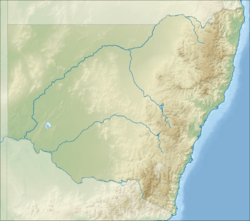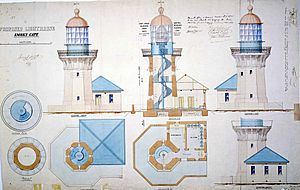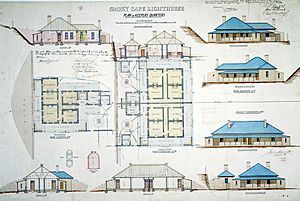Smoky Cape Lighthouse facts for kids
 |
|
| Smoky Cape Lighthouse, near South West Rocks | |
|
|
|
| Location | Smoky Cape New South Wales Australia |
|---|---|
| Coordinates | 30°55′22.4″S 153°05′14.5″E / 30.922889°S 153.087361°E |
| Year first constructed | 1891 |
| Automated | 1988 |
| Construction | concrete tower |
| Tower shape | octagonal tower with balcony and lantern attached to 1-story building |
| Markings / pattern | white tower and building |
| Height | 17.4 metres (57 ft) |
| Focal height | 128 metres (420 ft) |
| Original lens | First order Fresnel lens |
| Intensity | 1,000,000 cd |
| Range | 26 nautical miles (48 km; 30 mi) |
| Characteristic | Fl (3) W 20s. |
| Admiralty number | K2796 |
| NGA number | 6016 |
| ARLHS number | AUS-149 |
The Smoky Cape Lighthouse is a historic and active lighthouse located on Smoky Cape. This headland is found in Arakoon, east of South West Rocks, in New South Wales, Australia. It stands within the Hat Head National Park. The lighthouse helps guide boats towards the entrance of the Macleay River, which is just north of the lighthouse.
This lighthouse was one of the last major lighthouse buildings designed by James Barnet. He was the colonial architect at the time. It was also one of Australia's last lighthouses built with a focus on beautiful architecture. Standing on a granite headland 111 metres above the sea, its light is the highest in New South Wales.
The Smoky Cape Lighthouse was added to the New South Wales State Heritage Register on 2 April 1999. This means it is a very important historical site.
Contents
Discovering Smoky Cape Lighthouse
Why Was a Lighthouse Needed?
The area around South West Rocks was well known to sailors for many years. Captain James Cook first described "Smoky Cape" in his journal on May 13, 1770. He saw many fires on the headland, which made a lot of smoke.
Trial Bay, nearby, was seen as a safe place for ships during bad storms. This was important because shipping was the main way to transport goods and people along the eastern coast. However, the area was also dangerous. More than twenty shipwrecks happened near the headland. Some of these wrecks caused people to lose their lives. For example, nine people died when the ship Annie Ogle was wrecked in 1875.
Because of these dangers, people realized a lighthouse was needed. In 1886, a politician named Alexander Kethel pushed for a lighthouse to be built. He believed it would help the growing coastal trade and navigation.
Building the Lighthouse
About 18,000 pounds was set aside to build the lighthouse complex. James Barnet, the Colonial Architect, chose the perfect spot for it. He had also designed other important lighthouses in New South Wales.
Building began in 1889. The company chosen for the job was Oakes and Company. The plan included the lighthouse tower, the head keeper's house, and two cottages for assistant keepers. There was also a coach house and stables. All these buildings were to be built on an 81-acre area, 128 metres above sea level.
The light first shone on April 15, 1891. An official ceremony took place on April 29, 1891. Over the years, the light source was updated. In 1962, it was changed to an electric lamp. Around 1988, the lighthouse became automated, meaning it no longer needed keepers to operate it.
Lighthouse During Wartime
During World War II, the lighthouse area was used for military purposes. There was a searchlight battery and a gun emplacement there. You can still see the concrete remains of these military buildings today.
Opening for Visitors
On May 14, 1998, Smoky Cape Lighthouse became the first lighthouse in New South Wales to open for public tours. This allowed people to explore its history and enjoy its amazing views.
What Makes Smoky Cape Lighthouse Special?
Unique Design
The Smoky Cape Lighthouse has an unusual design. Its tower is octagonal, meaning it has eight sides. This shape was chosen because it was easier to build with concrete than a round tower. It also has a special entrance building and a cast-iron staircase inside.
It is one of only three lighthouses from the 1800s in New South Wales built using mass concrete. The others are South Solitary Island Lighthouse and Green Cape Lighthouse. The lighthouse still has its original Fresnel lens and revolving parts from the company Chance Brothers. This makes it a great example of old maritime technology.
The Lighthouse Tower
The lighthouse tower is 17.4 metres tall. It is made of thick concrete walls, which are wider at the bottom and get thinner towards the top. Inside, cast iron stairs lead up to the top where the light is.
The ground floor rooms were used for storage and work. The light source has been updated over time. The original lens is still there, but the light itself is now electric. The light still operates every night.
Homes for the Keepers
The lighthouse complex also includes several other buildings. These include the Head Lighthouse Keeper's Cottage and two cottages for the Assistant Keepers. There were also stables and other small buildings.
The Head Keeper's Cottage was built with several rooms, including bedrooms, a sitting room, and a kitchen. It had verandahs around most of it. The Assistant Keeper's Cottages were two homes joined together. They also had several rooms and were built from concrete. These homes were designed to give the keepers good views of the lighthouse.
Today, the Head Keeper's Cottage is a bed and breakfast. The two other cottages are rented out as holiday homes.
Visiting Smoky Cape Lighthouse
The lighthouse is managed by the Australian Maritime Safety Authority. It is also recognized as important by the National Trust of Australia.
The lighthouse complex is located inside Hat Head National Park. This means visitors can enjoy both the historical site and the beautiful natural surroundings.
Smoky Cape is a very popular spot for whale-watching. Many people come here to see whales migrating along the coast.
Why is it a Heritage Site?
Smoky Cape Lighthouse is very important because it shows how coastal shipping developed in the late 1800s. It combines the beauty of a rugged coastline with a significant landmark. The lighthouse still works today, using modern technology.
It is a great example of James Barnet's work, showing his unique architectural style. The site also shows how the area has been used over time, from Aboriginal communities to European settlement and even for military purposes during World War II.
The lighthouse is special because it was built using mass concrete, which was an early use of this material in Australia. Its original lens and lantern house are also rare examples of 19th-century industrial technology. Many people visit Smoky Cape Lighthouse to admire its character, setting, and history. It is highly valued by local communities as one of the oldest and most complete building complexes from the Colonial era.






